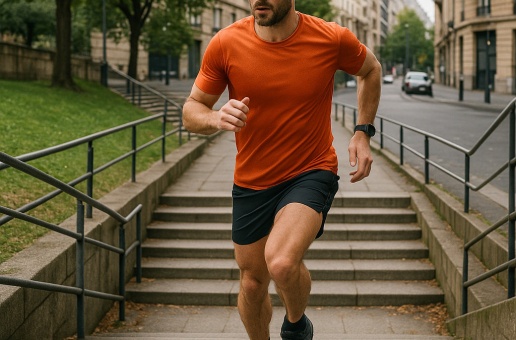Explore Urban Trail Running Benefits and Optimize Your Training
Par Sarah Publié le 04/10/2025 à 08h00 Temps de lecture : 2 minutes Crédit Image: AI Generated
Crédit Image: AI Generated
Discover the Benefits of Urban Trail Running
Urban trail running is a dynamic way to experience the thrill of nature while staying within city limits. For endurance athletes like triathletes, trail runners, swimmers, cyclists, and hikers, incorporating trail running in urban settings has a multitude of benefits that help enhance performance, improve mental well-being, and enable more effective training.
Benefits of Urban Trail Running
- Accessibility: Urban trail running offers easy access to trails without the hassle of traveling to remote areas. This makes it a convenient option for busy athletes.
- Diversity of Terrain: Running on trails within the city introduces varied terrains, incorporating dirt paths, grassy parks, and natural obstacles that challenge and improve your running technique.
- Increased Strength and Stability: The uneven surfaces of trails help build stabilizing muscles, improving overall strength, balance, and core stability, essential for other endurance sports.
- Mental Refreshment: Nature has been shown to reduce stress and improve mood. Running in green, urban spaces can enhance focus and motivation in your training.
- Social Engagement: Urban environments often have communities of runners. Participating in social runs or group training can enhance motivation and support.
Optimizing Your Training Without Leaving the City
Incorporating urban trail running into your training regimen doesn’t mean sacrificing efficiency. Here are practical tips on how to optimize your sessions:
1. Identify Local Trails
Take the time to explore local parks and green spaces where trails can be found. Mapping these locations beforehand can save time. Websites like AllTrails can provide maps and user reviews to ensure you choose the best routes.
2. Schedule Regular Trail Runs
Designate specific days in your training week as trail running days. Consistency is key. Even just one trail run each week can provide significant benefits. Incorporating various routes and terrains keeps your body challenged and engaged.
3. Incorporate Hill Repeats
Urban settings often have hills that can be integrated into your workouts. Hill repeats improve running economy, strength, and cardiovascular fitness. Find a suitable incline and aim for four to six repeats to build endurance.
4. Mix Speed Work with Trail Running
Include intervals or tempo runs within your trail sessions. These efforts can help build speed while taking advantage of your trail surroundings. Try running hard for a set period, then recover on an easier path.
5. Use Proper Footwear
A suitable pair of trail shoes is essential for urban trail running. Look for shoes designed for uneven terrain, with good grip to handle city trails, dirt paths, and any debris underfoot.
6. Pay Attention to Nutrition
Training in urban environments doesn't eliminate the need for proper nutrition. Make sure you're consuming enough carbohydrates and proteins to fuel your runs. Hydration is also crucial, so carry a water bottle or hydration pack when on longer runs.
7. Stay Mindful of Safety
Urban trails may have unexpected hazards like traffic, cyclists, and wildlife. Always be aware of your surroundings, and consider heading out during daylight hours for visibility and safety.
8. Utilize Technology
Rely on running apps or GPS watches to track your routes and improve your training. Apps like Strava or Garmin Connect allow you to record your runs and compare your performance over time, motivating you to challenge yourself further.
Frequently Asked Questions about Urban Trail Running
🧠 FAQ - Urban Trail Running Benefits and Training Tips
❓ What are the main benefits of urban trail running?
Urban trail running offers accessibility, diverse terrain, strength building, mental refreshment, and social opportunities for endurance athletes.
❓ How can I incorporate urban trail running into my training?
You can schedule regular trail runs, incorporate hill repeats, mix speed work, and explore local trails to enhance your training.
❓ What type of footwear is best for urban trail running?
A good pair of trail running shoes designed for uneven terrain with proper grip is ideal for urban trail running.
❓ Is safety a concern in urban trail running?
Yes, always be aware of your surroundings, watch for traffic, and consider running during daylight hours for better visibility.
❓ Can urban trail running improve my performance in other endurance sports?
Absolutely! The strength and stability gained from trail running can enhance your performance in cycling, swimming, and hiking as well.
❓ How often should I run on urban trails?
Aim for at least one dedicated urban trail run each week, but you can increase the frequency depending on your training schedule and goals.
Scientific Insights on Trail Running
Studies show that varied terrain such as urban trails enhances musculoskeletal strength due to the different surfaces runners face. A study published in the Journal of Strength and Conditioning Research indicates that runners who incorporate terrain variability in their training often have fewer injuries and greater overall performance improvements.
Conclusion: The City as Your Trail
Urban trail running presents a unique opportunity for endurance athletes to enhance their training and performance without extensive travel. By recognizing the benefits and optimizing your training, you can achieve significant improvements and enjoy the beauty of your city from a fresh perspective.







